Tenth Planet (Leaves)
RSP 13180
Grower: Kris James
General Information
- Sample Name
- Tenth_Planet_(Leaves)_20240722
- Accession Date
- July 28, 2024
- Reported Plant Sex
- Not Reported
- Report Type
- Whole-Genome Sequencing
- Microbiome
- Krona Plot
- Fungal Microbiome
- Krona Plot
- Bacterial Microbiome
- Krona Plot
- Viral Microbiome
- Krona Plot
The strain rarity visualization shows how distant the strain is from the other cultivars in the Kannapedia database. The y-axis represents genetic distance, getting farther as you go up. The width of the visualization at any position along the y-axis shows how many strains there are in the database at that genetic distance. So, a common strain will have a more bottom-heavy shape, while uncommon and rare cultivars will have a visualization that is generally shifted towards the top.
Chemical Information
Cannabinoid and terpenoid information provided by the grower.
Cannabinoids
No information provided.
Terpenoids
No information provided.
Genetic Information
- Plant Type
- Type I
File Downloads
The bell curve in the heterozygosity visualization shows the distribution of heterozygosity levels for cannabis cultivars in the Kannapedia database. The green line shows where this particular strain fits within the distribution. Heterozygosity is associated with heterosis (aka hybrid vigor) but also leads to the production of more variable offspring. When plants have two genetically different parents, heterozygosity levels will be higher than if it has been inbred or backcrossed repeatedly.
The ratio of reads mapped to Y-contigs to reads mapped to the whole Cannabis genome (Y-ratios) has been demonstrated to be strongly correlated with plant sex typing. This plot shows the distribution of Y-ratios for all samples in our database which were sequenced with the same method (panel or WGS) as this sample and where this sample falls in the distribution.
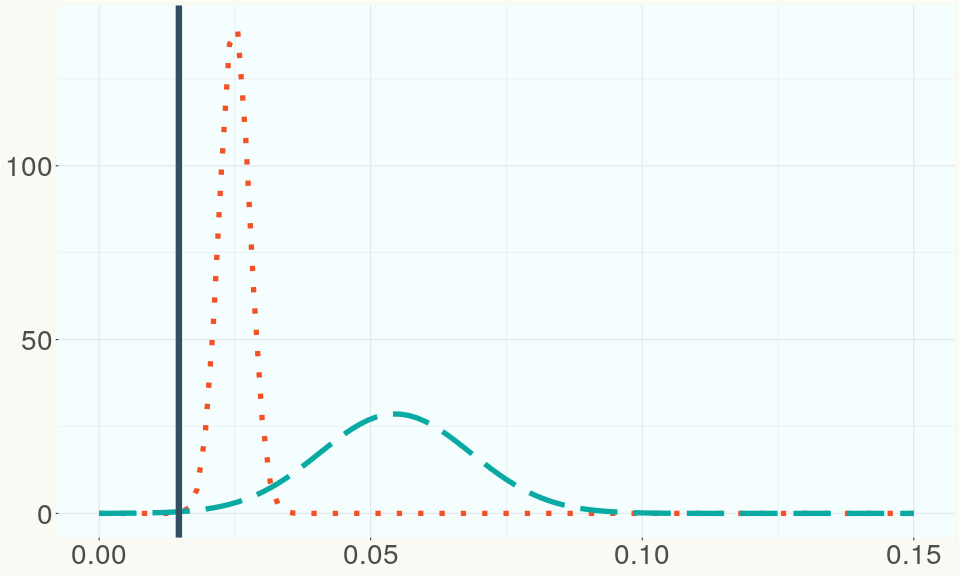
This chart represents the Illumina sequence coverage over the Bt/Bd allele. These are the three regions in the cannabis genome that impact THCA, CBDA, CBGA production. Coverage over the Active CBDAS gene is highly correlated with Type II and Type III plants as described by Etienne de Meijer. Coverage over the THCA gene is highly correlated with Type I and Type II plants but is anti-correlated with Type III plants. Type I plants require coverage over the inactive CBDA loci and no coverage over the Active CBDA gene. Lack of coverage over the Active CBDA and Active THCA allele are presumed to be Type IV plants (CBGA dominant). While deletions of entire THCAS and CBDAS genes are the most common Bt:Bd alleles observed, it is possible to have plants with these genes where functional expression of the enzyme is disrupted by deactivating point mutations (Kojoma et al. 2006).
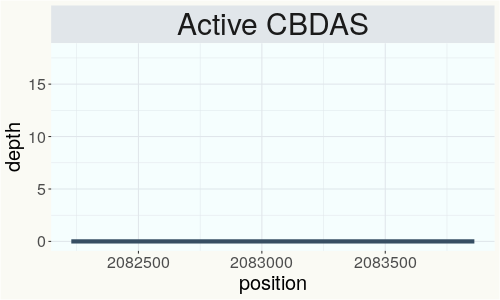
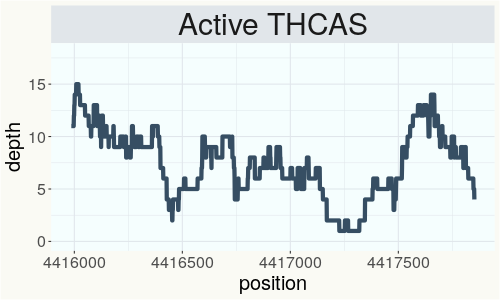
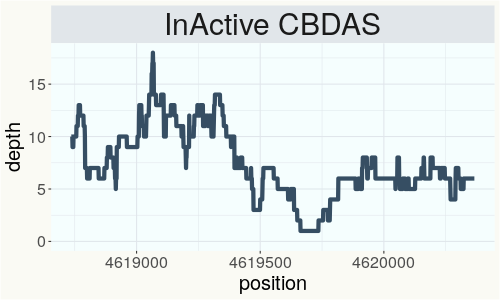
This chart represents the Illumina sequence coverage over the CBCA synthase gene.
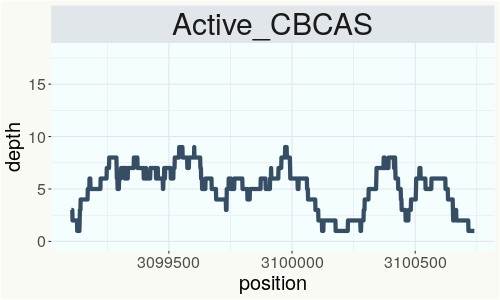
Variants (THCAS, CBDAS, and CBCAS)
No variants to report
Variants (Select Genes of Interest)
| PHL-2 | c.1057A>G | p.Arg353Gly | missense variant | moderate | contig2621 | 340335 | A/G | |
| PHL-2 | c.1096G>A | p.Ala366Thr | missense variant | moderate | contig2621 | 340374 | G/A | |
| PHL-2 | c.2756A>C | p.Glu919Ala | missense variant | moderate | contig2621 | 342799 | A/C | |
| PHL-2 | c.2783G>A | p.Ser928Asn | missense variant | moderate | contig2621 | 342826 | G/A | |
| PHL-2 | c.3202A>C | p.Thr1068Pro | missense variant | moderate | contig2621 | 343245 | A/C |
|
| PHL-2 | c.3209A>G | p.Gln1070Arg | missense variant | moderate | contig2621 | 343252 | A/G | |
| PKSG-4b | c.431T>G | p.Val144Gly | missense variant | moderate | contig700 | 2721242 | A/C | |
| PKSG-4b | c.134G>A | p.Arg45Gln | missense variant | moderate | contig700 | 2724301 | C/T |
|
| FAD2-2 | c.161T>A | p.Leu54His | missense variant | moderate | contig83 | 1803208 | A/T |
|
| ELF4 | c.144T>A | p.Asp48Glu | missense variant | moderate | contig869 | 622426 | A/T |
|
| ELF3 | c.520A>C | p.Asn174His | missense variant | moderate | contig97 | 242226 | A/C | |
| ELF3 | c.740A>G | p.Glu247Gly | missense variant | moderate | contig97 | 242446 | A/G |
|
| ELF3 | c.752G>T | p.Gly251Val | missense variant | moderate | contig97 | 242458 | G/T | |
| ELF3 | c.772A>G | p.Ser258Gly | missense variant | moderate | contig97 | 242478 | A/G |
|
| ELF3 | c.812G>C | p.Gly271Ala | missense variant | moderate | contig97 | 242518 | G/C | |
| ELF3 |
c.1230-2_123 |
splice acceptor variant & intron variant | high | contig97 | 243676 | TAG/T | ||
| PIE1-2 | c.5932A>G | p.Ile1978Val | missense variant | moderate | contig1460 | 1185552 | T/C | |
| FLD | c.2929T>C | p.Phe977Leu | missense variant | moderate | contig1450 | 2044103 | A/G | |
| FLD | c.2686G>A | p.Ala896Thr | missense variant | moderate | contig1450 | 2044848 | C/T | |
| FLD | c.2681T>C | p.Ile894Thr | missense variant | moderate | contig1450 | 2044853 | A/G | |
| PKSB-3 | c.1946C>T | p.Pro649Leu | missense variant | moderate | contig93 | 3340053 | C/T |
|
Nearest genetic relatives (All Samples)
- 0.127 Tenth Planet Roots (RSP13179)
- 0.177 Blueberry Cheesecake (RSP10684)
- 0.178 Trump x Trump (RSP11466)
- 0.182 Electra (RSP11366)
- 0.183 Serious Happiness (RSP10763)
- 0.194 Doug s Varin (RSP11243)
- 0.195 Rest (RSP11377)
- 0.198 Thank You Jerry (RSP11459)
- 0.203 Suver Haze (RSP11364)
- 0.203 Banana Daddy 1 Big (RSP11496)
- 0.204 SPQ (RSP11370)
- 0.207 Domnesia (RSP11184)
- 0.211 JL Cross 10 (RSP11511)
- 0.212 Lift (RSP11378)
- 0.213 Tahoe OG (RSP11189)
- 0.219 Liberty Haze (RSP11000)
- 0.220 Badger (RSP11614)
- 0.223 GG 4 (RSP11461)
- 0.224 CPH (RSP11367)
- 0.227 JL Cross 11 (RSP11512)
Most genetically distant strains (All Samples)
- 0.517 Jamaican Lion (RSP12916)
- 0.499 JL yellow (RSP11075)
- 0.487 Jamaican Lion (RSP12917)
- 0.476 Jamaican Lion (RSP12915)
- 0.469 Jamaican Lion (RSP12913)
- 0.462 JL 3rd Gen Mother (RSP11214)
- 0.440 JL 3rd Gen Father (RSP11196)
- 0.428 JL 4th Gen 5 (RSP11199)
- 0.425 Jamaican Lion (RSP12920)
- 0.424 JL 4th Gen 1 (RSP11193)
- 0.422 JL 4th Gen 2 (RSP11194)
- 0.417 Jamaican Lion (RSP12919)
- 0.415 JL 3rd Gen Mother (RSP11197)
- 0.414 Jamaican Lion (RSP12918)
- 0.413 Punta Roja (RSP12923)
- 0.408 Roze Zkittles x Unknown (RSP12925)
- 0.407 JL 4th Gen 4 (RSP11198)
- 0.405 JL 4th Gen 6 (RSP11200)
- 0.403 R1in136 (SRR14708226)
- 0.400 IUP3 (SRR14708256)
Nearest genetic relative in Phylos dataset
- Overlapping SNPs:
- 62
- Concordance:
- 38
Nearest genetic relative in Lynch dataset
- Overlapping SNPs:
- 6
- Concordance:
- 5
Blockchain Registration Information
- Transaction ID
-
18c17129f1e5ecfd
45a76c5dd49a4a28 3783e67730c73a6f 7ca8d53f0c4c2c7d - Stamping Certificate
- Download PDF (39.6 KB)
- SHASUM Hash
-
35ea4619b6dab623ca00c16c3d96ef7b bb72ee2263f9144f da2b31aa2635ca9a